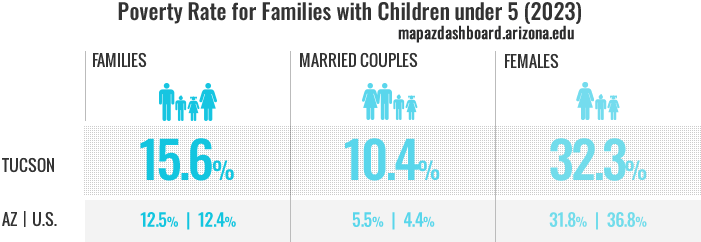 Read About Poverty Rates in Tucson, Arizona MSA
Read About Poverty Rates in Tucson, Arizona MSA
How are we doing?
Poverty Rate (2023)

The poverty rate in the Tucson Metropolitan Statistical Area (MSA) was 14.4% in 2023. That ranked Tucson 10th among 12 western MSAs, among which Salt Lake City had the lowest poverty rate at 8.1% and El Paso the highest at 18.9%. Tucson’s poverty rate has improved substantially since 2018 decreasing by more than three percentage points.
Poverty rates were lowest among Asians and white, non-Hispanic individuals in Tucson. By age breakdown (under 18 years; 18-64 years; 65 years or more), the highest poverty rates occurred among those under 18 years, while the lowest rates were found among those 65 years or older. Poverty rates also varied by family type, with the highest rates found among female-headed households with children under five.
Why is it important?
The poverty rate is an important indicator of financial distress among households. Families whose income is near or below the poverty level have difficulty accessing necessities such as housing, food, and healthcare. Local poverty rates are also important drivers of government decisions related to spending on programs such as affordable housing, free and reduced school lunches, and other forms of public assistance. Further, poverty rates have been linked to undesirable social outcomes, reduced regional homeownership rates, as well as a decreased likelihood of attending college.
How do we compare?
In 2023, all individuals in Tucson experienced higher poverty rates than national rates, except for the Black or African American population. Native Hawaiian and Pacific Islanders experienced the largest gap with a poverty rate that was more than 26 percentage points higher. The poverty rate for the American Indian and Alaska Native population in Tucson also exceeded the national rate by a significant amount. The white, non-Hispanic population posted the lowest poverty rate in Tucson at 10.8%.
Young populations experienced higher poverty rates in Tucson (18.7%) and Arizona (17.0%), in comparison to the U.S. (16.3%). The working-age population (18–64 years) also had higher poverty rates in Tucson at 14.9%, and Arizona at 12.1%, than the U.S. at 11.6%. Only those 65 years and older had lower poverty levels in Tucson at 8.9%, in comparison to 10.4% for the U.S.
Families with children under five had poverty rates roughly comparable to the general population in all three comparison geographies. Married couple-families had significantly lower rates at 10.4% in Tucson, 5.5% in Arizona, and 4.4% in the U.S. Female-headed households with no spouse present, and with children under five years, however, had significantly higher rates in all three geographies: 32.3% in Tucson, 31.8% in Arizona, and 36.8% in the U.S.

What are the key trends?
In 2000, the poverty rates in Tucson, the state of Arizona, and the U.S. were 14.7%, 13.9%, and 12.4%, respectively. Stagnant wages combined with increased costs for housing and transportation contributed to rising poverty rates between 2000 and 2018. The Great Recession also played a large role in the high poverty rates posted during and preceding that period. The poverty rate has declined significantly since, in part due to the stimulus packages provided by the government during the COVID-19 pandemic. In 2023, the poverty rate dropped to 14.4% in Tucson. That was a 25-year low and below Tucson’s rate of 14.7% in 2000. Similarly, Arizona posted a lower poverty rate in 2023 than in 2000, while nationally the poverty rate fell back to its 2000 rate.
How is it measured?
Poverty rates are from U.S. Census Bureau American Community Survey (ACS) five-year estimates. Note that the ACS five-year estimates are produced over a five-year time period and can only be compared to non-overlapping five-year estimates (for example: 2006-2010 and 2011-2015). Rates reported by the U.S. Census Bureau are derived from answers to ACS questions regarding household income, age, and family composition. Income includes “before-tax earnings, unemployment compensation, workers' compensation, Social Security, Supplemental Security Income, public assistance, veterans' payments, survivor benefits, pension or retirement income, interest, dividends, rents, royalties, income from estates, trusts, educational assistance, alimony, child support, assistance from outside the household, and other miscellaneous sources”. According to the U.S. Census Bureau, a family is considered below the poverty level if their annual household income falls below a threshold that is based on annual income, age, and family size. For example, the poverty threshold for a family of five with three related children under 18 years in 2023 was $35,140.












